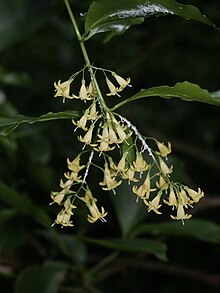| Chiococca alba | |
|---|---|

| |
| Scientific classification | |
| Kingdom: | Plantae |
| Clade: | Tracheophytes |
| Clade: | Angiosperms |
| Clade: | Eudicots |
| Clade: | Asterids |
| Order: | Gentianales |
| Family: | Rubiaceae |
| Genus: | Chiococca |
| Species: | C. alba
|
| Binomial name | |
| Chiococca alba | |
| Synonyms | |
Chiococca alba is a species of flowering plant in the coffee family (Rubiaceae) native to Florida and the extreme southern tip of Texas in the United States,[4] Bermuda,[3] Mexico, Central America, the Caribbean, the Galápagos, and tropical South America. Common names include David's milkberry, West Indian milkberry, cahinca[5] and West Indian snowberry.[6] The specific epithet, alba, means "white" in Latin and refers to the color of its fruits.[7]
- ^ Roberts, A. (2014). "Chiococca alba". IUCN Red List of Threatened Species. 2014: e.T56503531A56503966. doi:10.2305/IUCN.UK.2014-1.RLTS.T56503531A56503966.en. Retrieved 13 November 2022.
- ^ a b "Chiococca alba". Germplasm Resources Information Network. Agricultural Research Service, United States Department of Agriculture. Retrieved 2010-04-19.
- ^ a b Sarkis, Samia (December 2009). "Recovery plan for eight species of flowering plants, Carex bermudia, Peperomia septentrionalis, Phaseolus lignosus, Erigeron darrellianus, Galium bermudense, Hypericum hypericoides, Psychotria lingustrifolia, in Bermuda" (PDF). Department of Conservation, Bermuda: 4. Archived from the original (PDF) on 2011-07-06.
{{cite journal}}: Cite journal requires|journal=(help) - ^ "David's Milkberry, Snowberry, Milkberry, David's Root, Perlilla, Canica, Cahinca, Cainea, Caninara, Aceitillo, Madreselva, Lagrimas de San Pedro, Lagrimas de Maria, Oreja de Raton, Suelda, Consuelda, Bejuco de Berac, Bejuco de Berraco, Xcanchac-che". Texas A&M University. Retrieved 2009-12-11.
- ^ "Chiococca alba (L.) A.S. Hitchc". Native Plant Information Network. Lady Bird Johnson Wildflower Center. Retrieved 2009-12-11.
- ^ "Chiococca alba (L.) A.S. Hitchc. West Indian snow-berry" (PDF). International Institute of Tropical Forestry. United States Forest Service. Retrieved 2009-12-11.
- ^ Hammer, Roger L. (2004). Florida Keys Wildflowers: A Field Guide to Wildflowers, Trees, Shrubs, and Woody Vines of the Florida Keys. Globe Pequot. p. 104. ISBN 978-0-7627-2569-4.[permanent dead link]
